Art & Exhibitions
Art World Report Card: Andy Warhol’s Women
Ranking Warhol's women and the importance of Twitter followers.

Ranking Warhol's women and the importance of Twitter followers.

Alexandra Peers

Warhol’s Women
I wonder if someday Andy Warhol‘s art will be analyzed, cataloged and dissected much like Picasso’s – in accordance with the women in his life.
Any art history student knows the details of Picasso’s paramours: weepy Dora, lush, lounging Marie-Therese, angular Jacqueline — and when Grecian wife Olga found out about most of them.
Will Warhol’s women be similarly touchstones — a shorthand to discuss what was going on at the time in Warhol’s mind and in the world?
A flurry of art shows argue yes. Blain DiDonna, the Carlyle Hotel Gallery of the affable Brit and the ex-Sotheby’s specialist is showing Jackie Kennedy images. At the Norton Museum of Art in Palm Beach, Florida, Jean Holzer, better known as Factory co-founder Baby Jane, is being given a tribute in “Warhol’s First Superstar.” Chelsea’s Dillon Gallery presents “Ultra Violet: The Studio Recreated,” from April 24 to May 24. (Larry Gagosian, often early on such things, did a recent exhibition, in Paris, of Warhol’s Brigitte Bardots.)
Of course, it’s not quite the same at all: these women were not Warhol’s lovers, and, in some cases he never even met them.
Nonetheless, “There were so many pivotal women in Andy’s life, he had so many muses,” notes Eric Shiner, director of the Andy Warhol Museum in Pittsburgh.
Warhol has thousands of works (paintings, films, Polaroids) focused on females: The Marilyns, the Lizzes, the dealer portraits (Ileana Sonnabend, Holly Solomon), friends and idols (Liza, Deborah Harry), the commissioned and socialite portraits, and the “Ladies and Gentlemen” series: the drag queens.
Warhol’s muses, says Shiner, started with his mother, Julia Warhola, who was a talented calligrapher and whose words appear in his 1950s drawings. (Shiner was in New York for the opening of the Queens Museum show of Warhol’s “Most Wanted,” sadly, or perhaps not, a series of only men.)
But for art consultant and curator Todd Levin, of the Levin Art Group, it all comes down to Marilyn, Liz, and Jackie. “There’s a clear kind of dividing line between [that trio] and everything and anything else…a stark and clear demarcation. Everything else breaks down to society portrait or commissioned portrait in one way or another.” The three are all part of Warhol’s death obsession, he notes.
In the artist’s own book (with Pat Hackett) “Popism: The Warhol Sixties,” Warhol wrote that he ‘started doing silkscreens’ in August and that ‘when Marilyn Monroe happened to die that month, I got the idea to make screens of her beautiful face.’
The Jackies similarly began after the president’s murder, with four images of the First Lady chosen from before his death and four after, says Emmanuel DiDonna.
The Liz series, on its surface not about death, began not long after she suffered a series of serious ilnesses, one of them reported as a suicide attempt in the tabloid press. (Liz is a favorite of Larry’s: a Taylor pictures is so iconic its the private collection of Gagosian, as displayed at Abu Dhabi’s Saadiyat Island in 2010.)
Every art worlder has their favorite Warhol Woman. Notes Michael Briggs, Los Angeles art dealer: “ I always like Warhol’s Bardot images – she always epitomized a classic beauty to me and I always thought no one paid enough attention to them. Probably since they were made in the 70s rather than the classic 60s period.”
As for Shiner’s favorites, he picks two from the museum collection: a vivid colored aqua and purple Grace Jones and a Dolly Parton. Shiner notes that another Parton is in the collection of Crystal Bridges Museum, as purchased by Walmart heiress Alice Walton. The series of Parton portraits, with their big hair and big earrings, “They embody her essence, her larger-than-life persona.”
Will it matter to the art’s value or import, as decades go by, that some of these women don’t remain famous—except perhaps for being painted by Warhol?
Just ask the Mona Lisa.

Jackie. c. 1968
Collage with screenprinted acetate and paper on board 21 1/4 by 21 1/8 in. (54 by 53.6 cm)
PRIVATE COLLECTION
Scrimmage by the Keyboard
Warm thanks to the excellent blog Art F city for taking on, and taking me to task for, last week’s “Seven Surprising Ways the Internet has Screwed the Art World.” They make good points, though it is disconcerting to see a couple of sentences that begin with things like “She claims…” that restate my opinions in ways that had me saying to myself “I didn’t mean that at all!”
But the one true dispute we have is about Twitter. AFC contends that “Twitter followers do not make for a more “powerful” museum; more importantly, an increase in followers does not necessarily mean an increase in financial resources—like more grant funding—or an increase in acquisitions.” I disagree completely, Twitter followers are a measure of influence, popularity, circulation that will eventually but predictably translate into the traditional measures of power.
Art World Report Card appears every Thursday on artnet news. Contact the author at [email protected]. Follow her on Twitter at @LoisLaneNY.